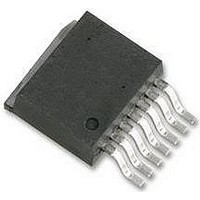LM22679TJ-ADJ National Semiconductor, LM22679TJ-ADJ Datasheet - Page 9

LM22679TJ-ADJ
Manufacturer Part Number
LM22679TJ-ADJ
Description
REGULATOR, ADJ. VOLTAGE, 5A 7TO263
Manufacturer
National Semiconductor
Datasheet
1.LM22679TJ-ADJ.pdf
(14 pages)
Specifications of LM22679TJ-ADJ
Primary Input Voltage
42V
No. Of Outputs
1
Output Current
5A
Voltage Regulator Case Style
TO-263
No. Of Pins
7
Operating Temperature Range
-40°C To +125°C
Svhc
No SVHC (15-Dec-2010)
Package
RoHS Compliant
Available stocks
Company
Part Number
Manufacturer
Quantity
Price
Company:
Part Number:
LM22679TJ-ADJ/NOPB
Manufacturer:
TI
Quantity:
16 500
where F is the switching frquency which is 500 kHz (typical).
This procedure provides a guide to select the value of the
inductor L. The nearest standard value will then be used in
the circuit. Increasing the inductance will generally slow down
the transient response but reduce the output voltage ripple
amplitude. Reducing the inductance will generally improve
the transient response but increase the output voltage ripple.
The inductor must be rated for the peak current, I
vent saturation. During normal loading conditions, the peak
current occurs at maximum load current plus maximum ripple.
Under an overload condition as well as during load transients,
the peak current is limited to 7.1A typical (8.75A maximum).
This requires that the inductor be selected such that it can run
at the maximum current limit and not only the steady state
current.
Depending on inductor manufacturer, the saturation rating is
defined as the current necessary for the inductance to reduce
by 30% at 20°C. In typical designs the inductor will run at
higher temperatures. If the inductor is not rated for enough
current, it might saturate and due to the propagation delay of
the current limit circuitry, the power supply may get damaged.
Input Capacitor
Good quality input capacitors are necessary to limit the ripple
voltage at the VIN pin while supplying most of the switch cur-
rent during on-time. When the switch turns on, the current into
the VIN pin steps to the peak value, then drops to zero at turn-
off. The average current into VIN during switch on-time is the
load current. The input capacitance should be selected for
RMS current, IRMS, and minimum ripple voltage. A good ap-
proximation for the required ripple current rating necessary is
I
Quality ceramic capacitors with a low ESR should be selected
for the input filter. To allow for capacitor tolerances and volt-
age effects, multiple capacitors may be used in parallel. If step
input voltage transients are expected near the maximum rat-
ing of the LM22679, a careful evaluation of ringing and pos-
sible voltage spikes at the VIN pin should be completed. An
additional damping network or input voltage clamp may be
required in these cases.
Usually putting a higher ESR electrolytic input capacitor in
parallel to the low ESR bypass capacitor will help to reduce
excessive voltages during a line transient and will also move
the resonance frequency of the input filter away from the reg-
ulator bandwidth.
Output Capacitor
The output capacitor can limit the output ripple voltage and
provide a source of charge for transient loading conditions.
Multiple capacitors can be placed in parallel. Very low ESR
capacitors such as ceramic capacitors reduce the output rip-
ple voltage and noise spikes, while larger higher ESR capac-
itors in parallel provide large bulk capacitance for transient
loading conditions. An approximation for the output voltage
ripple is:
where ΔI
RMS
> I
OUT
L
is the inductor ripple current.
/ 2.
PK+
, to pre-
9
Cboot Capacitor
The bootstrap capacitor between the BOOT pin and the SW
pin supplies the gate current to turn on the N-channel MOS-
FET. The recommended value of this capacitor is 10nF and
should be a good quality, low ESR ceramic capacitor.
It is possible to put a small resistor in series with the Cboot
capacitor to slow down the turn-on transition time of the in-
ternal N-channel MOSFET. Resistors in the range of 10Ω to
50Ω can slow down the transition time. This can reduce EMI
of a switched mode power supply circuit. Using such a series
resistor is not recommended for every design since it will in-
crease the switching losses of the application and makes
thermal considerations more challenging.
Resistor Divider
For the -5.0 option no resistor divider is required for 5V output
voltage. The output voltage should be directly connected to
the FB pin. Output voltages above 5V can use the -5.0 option
with a resistor divider as an alternative to the -ADJ option.
This may offer improved loop bandwidth in some applications.
See the Internal Compensation section for more details.
For the -ADJ option no resistor divider is required for 1.285V
output voltage. The output voltage should be directly con-
nected to the FB pin. Other output voltages can use the -ADJ
option with a resistor divider.
The resistor values can be determined by the following equa-
tions:
-ADJ option:
-5.0 option:
Where V
-5.0 option
A maximum value of 10 kΩ is recommended for the sum of
R1 and R2 to keep high output voltage accuracy for the –ADJ
option. A maximum of 2 kΩ is recommended for the -5.0 out-
put voltage option. For the 5V fixed output voltage option, the
total internal divider resistance is typically 9.93 kΩ.
At loads less than 5 mA, the boot capacitor will not hold
enough charge to power the internal high side driver. The
output voltage may droop until the boot capacitor is
FB
FIGURE 3. Resistive Feedback Divider
= 1.285V typical for the -ADJ option and 5V for the
30072323
www.national.com











